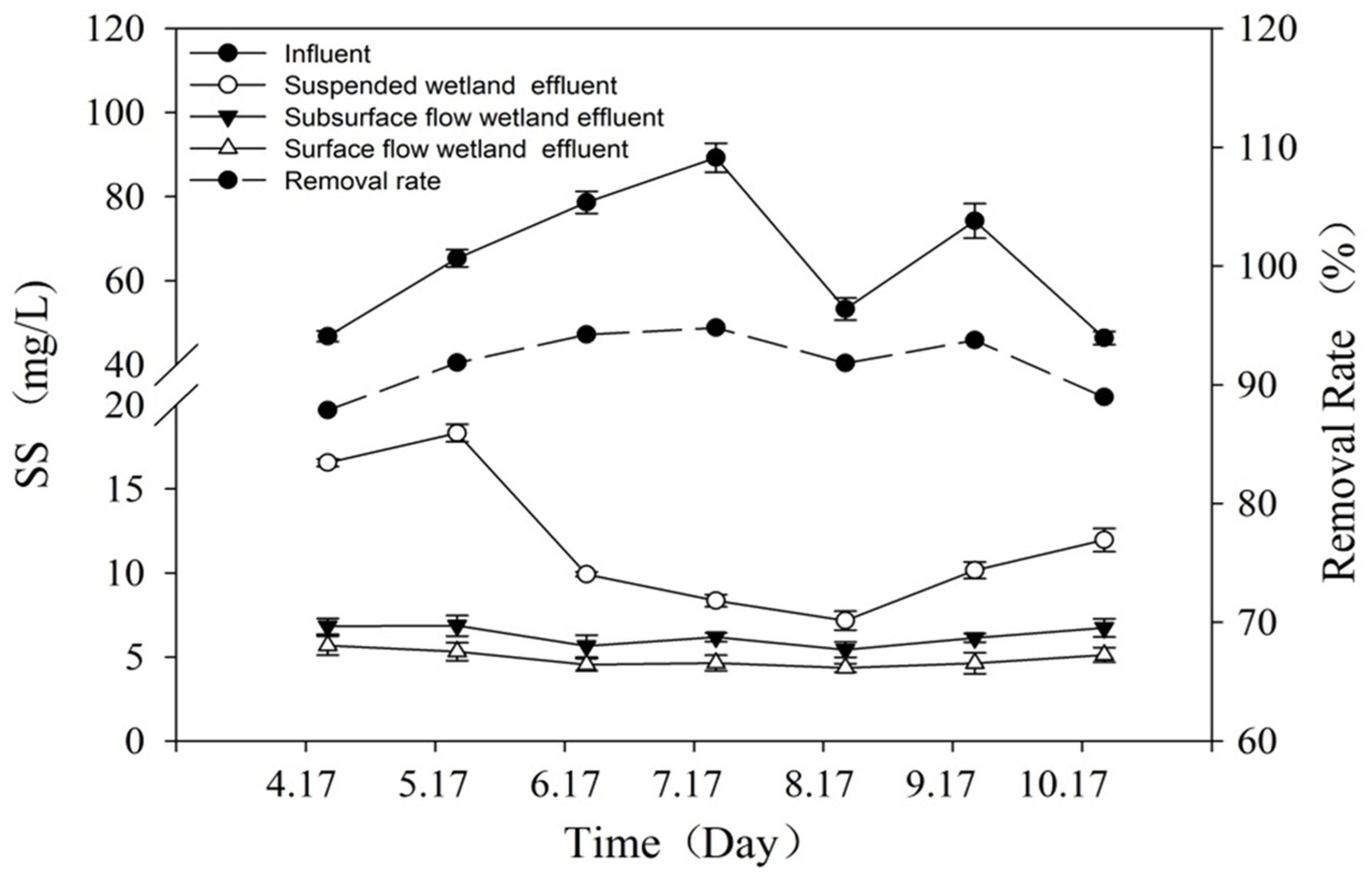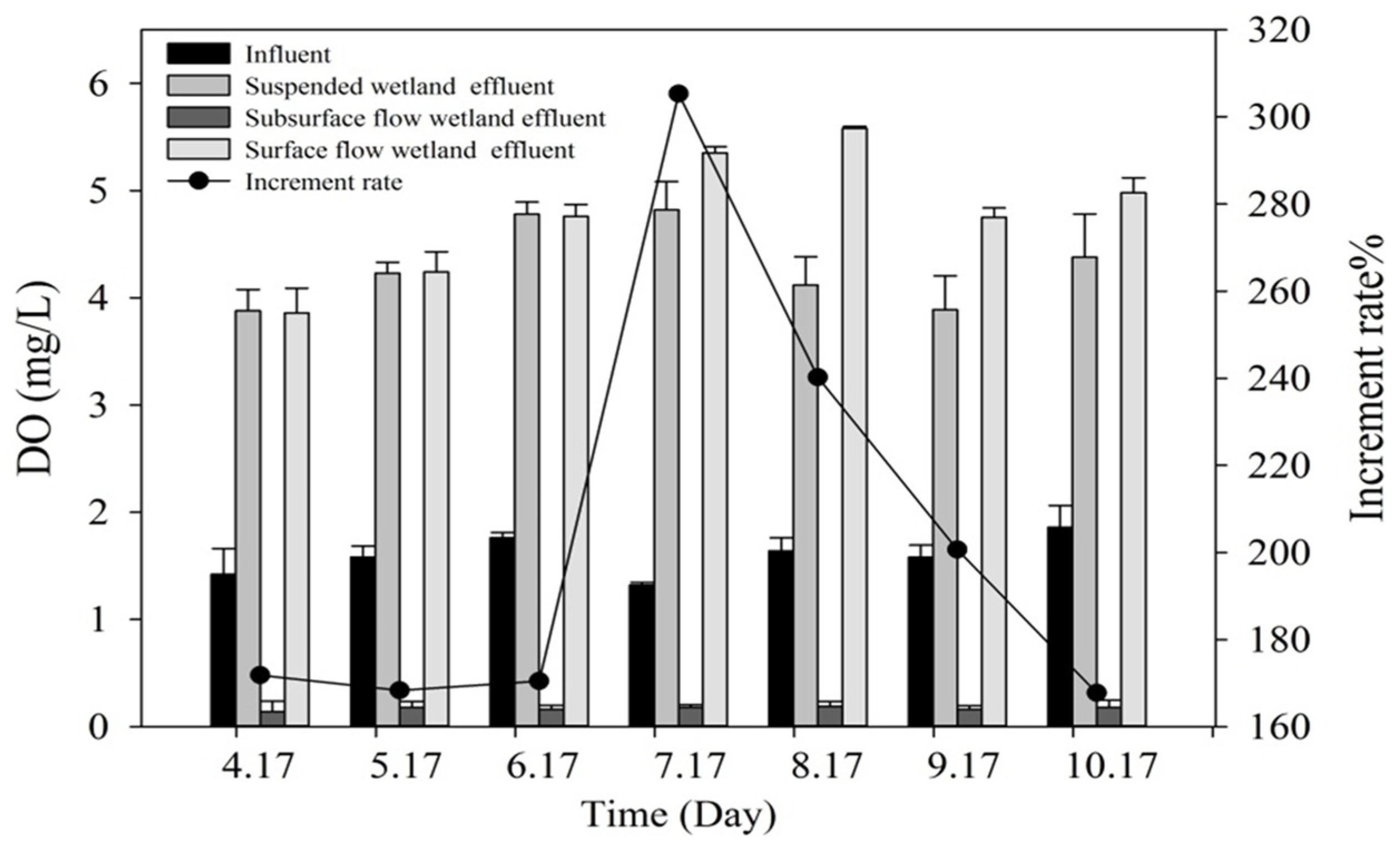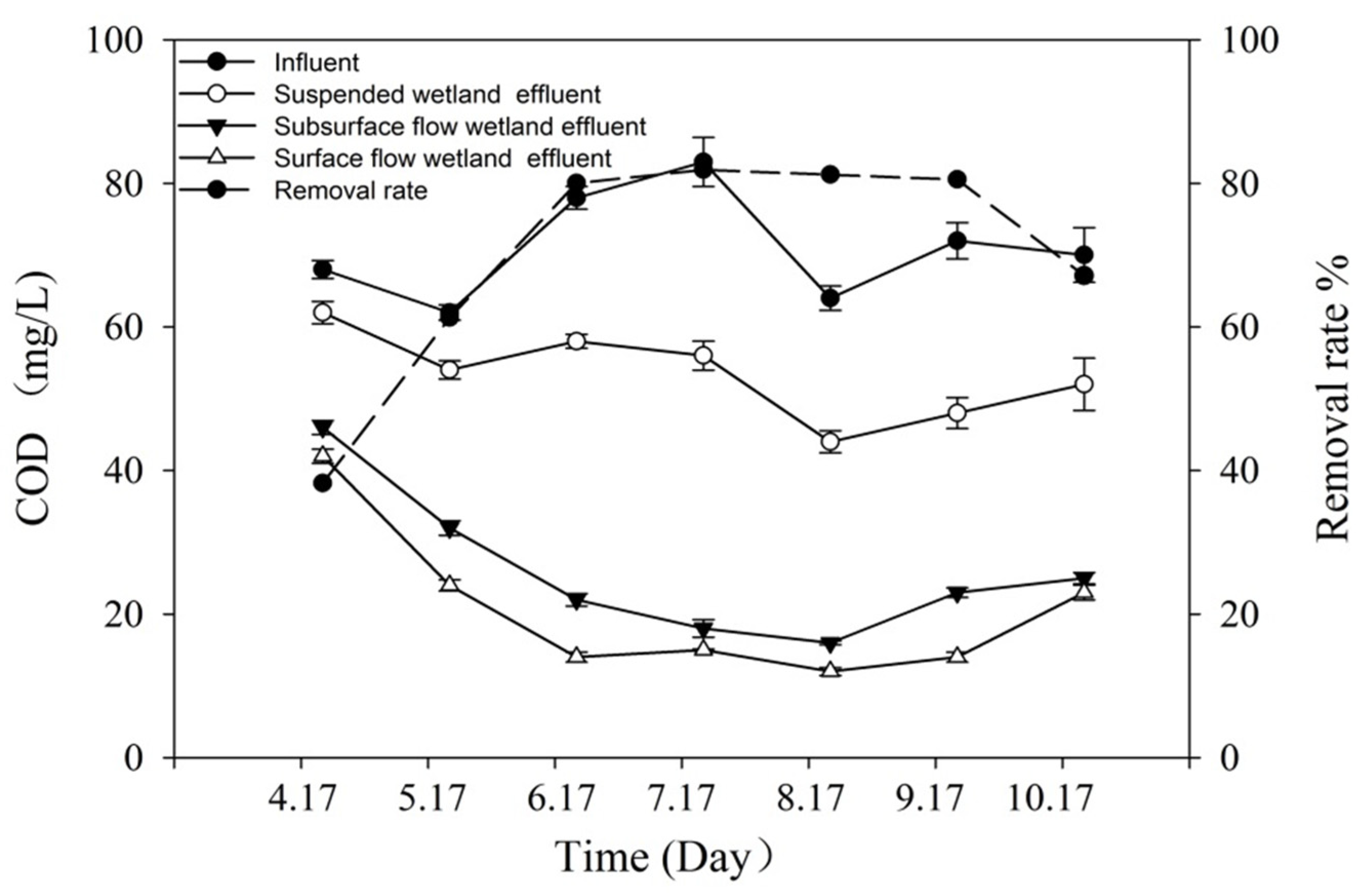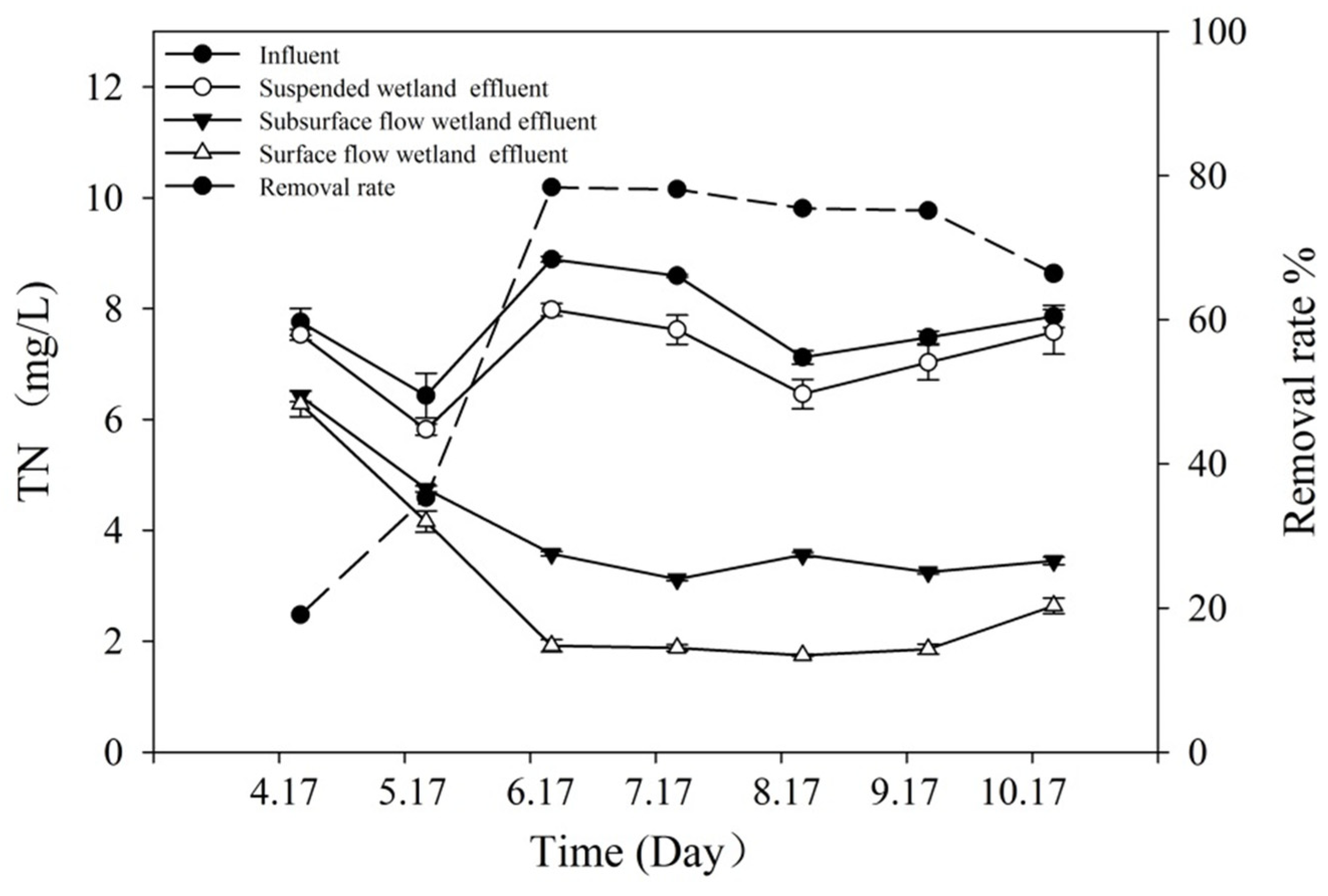Purification Effect of Sequential Constructed Wetland for the Polluted Water in Urban River
Abstract
:1. Introduction
2. Method
2.1. Study Area
2.2. Ecological Engineering Design
2.3. Data Collection and Analysis
3. Results
4. Discussion
5. Conclusions
Author Contributions
Funding
Conflicts of Interest
References
- Magdaleno, A.; Puig, A.; Cabo, L.D.; Salinas, C. Water Pollution in an Urban Argentine River. B. Environ. Contam. Tox. 2001, 67, 0408–0415. [Google Scholar] [CrossRef] [PubMed]
- Cao, J.X.; Sun, Q.; Zhao, D.H.; Xu, M.Y.; Shen, Q.S.; Wang, D.; Wang, Y.; Ding, S.M. A critical review of the appearance of black-odorous water bodies in China and treatment methods. J. Hazard. Mater. 2020, 385, 121511. [Google Scholar] [CrossRef] [PubMed]
- Zhong, F.; Wu, J.; Dai, Y.; Xiang, D.; Deng, Z.; Cheng, S. Responses of water quality and phytoplankton assemblages to remediation projects in two hypereutrophic tributaries of Chaohu Lake. J. Environ. Manag. 2019, 248, 109276. [Google Scholar] [CrossRef] [PubMed]
- Zhu, W.-B.; Wang, H.-X.; Liu, C.; Zhang, J.; Liang, S. Improvement of River Water Quality by Aeration: WASP Model Study. Environ. Sci. 2015, 36, 1326–1331. [Google Scholar]
- Fathollahzadeh, H.; Kaczala, F.; Bhatnagar, A.; Hogland, W. Significance of environmental dredging on metal mobility from contaminated sediments in the Oskarshamn Harbor, Sweden. Chemosphere 2015, 119, 445–451. [Google Scholar] [CrossRef] [PubMed]
- Chen, M.; Cui, J.; Lin, J.; Ding, S.; Gong, M.; Ren, M.; Tsang, D.C. Successful control of internal phosphorus loading after sediment dredging for 6, years: A field assessment using high-resolution sampling techniques. Sci. Total Environ. 2018, 616, 927–936. [Google Scholar] [CrossRef]
- Jing, L.; Bai, S.; Li, Y.; Peng, Y.; Wu, C.; Liu, J.; Liu, G.; Xie, Z.; Yu, G. Dredging project caused short-term positive effects on lake ecosystem health: A five-year follow-up study at the integrated lake ecosystem level. Sci. Total Environ. 2019, 686, 753–763. [Google Scholar] [CrossRef]
- Kasprzak, P.; Gonsiorczyk, T.; Grossart, H.P.; Hupfer, M.; Koschel, R.; Petzoldt, T.; Wauer, G. Restoration of aeutrophic hard-water lake by applying an optimised dosage of poly-aluminium chloride (PAC). Limnologica 2018, 70, 33–48. [Google Scholar] [CrossRef]
- Jin, X.; Bi, L.; Lyu, T.; Chen, J.; Zhang, H.; Pan, G. Amphoteric starch-based bicomponent modified soil for mitigation of harmful algal blooms (HABs) with broad salinity tolerance: Flocculation, algal regrowth, and ecological safety. Water Res. 2019, 165, 115005. [Google Scholar] [CrossRef]
- Vezzulli, L.; Pruzzo, C.; Fabiano, M. Response of the bacterial community to in situ bioremediation of organic-rich sediments. Mar. Pollut. Bull. 2004, 49, 740–751. [Google Scholar] [CrossRef]
- Jarvie, H.P.; Neal, C.; Warwick, A.; White, J.; Neal, M.; Wickham, H.D.; Hill, L.K.; Andrews, M.C. Phosphorus uptake into algal biofilms in a lowland chalk river. Sci. Total. Environ. 2002, 282, 353–373. [Google Scholar] [CrossRef]
- Cai, X.; Yao, L.; Sheng, Q.; Jiang, L.; Wang, T.; Dahlgren, R.A.; Deng, H. Influence of a biofilm bioreactor on water quality and microbial communities in a hypereutrophic urban river. Environ. Technol. 2019, 1, 1–34. [Google Scholar] [CrossRef] [PubMed] [Green Version]
- Juang, D.F.; Tsai, W.P.; Liu, W.K. Treatment of polluted river water by a gravel contact oxidation system constructed under riverbed. Int. J. Environ. Sci. Technol. 2008, 5, 305–314. [Google Scholar] [CrossRef] [Green Version]
- Li, L.; Xie, S.; Zhang, H.; Wen, D. Field experiment on biological contact oxidation process to treat polluted river water in the Dianchi Lake watershed. Front. Environ. Sci. Eng. China 2009, 3, 38–47. [Google Scholar] [CrossRef]
- Xu, J.; Lo, S.L. A case study on gravel-contact-aeration-oxidation system to treat the combined sewage and rainwater flowing into Keelung River, Taiwan. Desalin. Water Treat. 2019, 156, 32–37. [Google Scholar] [CrossRef]
- Li, L.; Visvanathan, C. Membrane technology for surface water treatment: advancement from microfiltration to membrane bioreactor. Rev. Environ. Sci. Bio/Technology 2017, 16, 737–760. [Google Scholar] [CrossRef]
- Sun, W.; Li, C.; Dong, B.; Chu, H. A Pilot-scale diatomite membrane bioreactor for slightly polluted surface water treatment. CLEAN-Soil, Air, Water 2018, 46, 1700117. [Google Scholar] [CrossRef]
- Rushton, B.T.; Bahk, B.M. Treatment of stormwater runoff from row crop farming in Ruskin, Florida. Water Sci. Technol. 2001, 44, 531–538. [Google Scholar] [CrossRef]
- Jurczak, T.; Wojtal-Frankiewicz, A.; Kaczkowski, Z.; Oleksińska, Z.; Bednarek, A.; Zalewski, M. Restoration of a shady urban pond-The pros and cons. J. Environ. Manag. 2018, 217, 919–928. [Google Scholar] [CrossRef]
- Lu, X.M.; Huang, M.S. Nitrogen and phosphorus removal and physiological response in aquatic plants under aeration conditions. International journal of Environ. Int. J. Environ. Sci. Technol. 2010, 7, 665–674. [Google Scholar] [CrossRef] [Green Version]
- Yu, L.; Zhang, Y.; Liu, C.; Xue, Y.; Shimizu, H.; Wang, C.; Zou, C. Ecological responses of three emergent aquatic plants to eutrophic water in Shanghai, P. R. China. Ecol. Eng. 2019, 136, 134–140. [Google Scholar] [CrossRef]
- Zhou, X.; Wang, G. Nutrient concentration variations during Oenan the javanica growth and decay in the ecological floating bed system. J. Environ. Sci. 2010, 22, 1710–1717. [Google Scholar] [CrossRef]
- Zheng, L.; Yang, R.; Wang, H.; Song, J. Study on water remediation and uptake ability of nitrogen and phosphorus by plants using combined ecological floating bed. Chinese J. Environ. Eng. 2013, 7, 2153–2159. [Google Scholar]
- Samal, K.; Kar, S.; Trivedi, S. Ecological floating bed (EFB) for decontamination of polluted water bodies: Design, mechanism and performance. J. Environ. Manag. 2019, 251, 109550. [Google Scholar] [CrossRef]
- Jing, S.R.; Lin, Y.F. Seasonal Effects on Ammonium Nitrogen Removal by Constructed Wetlands Treating Polluted River Water in Southern Taiwan. Environ. Pollut. 2004, 127, 291–301. [Google Scholar] [CrossRef]
- Jia, H.; Sun, Z.; Li, G. A four-stage constructed wetland system for treating polluted water from an urban river. Ecol. Eng. 2014, 71, 48–55. [Google Scholar] [CrossRef]
- Liu, G.; He, T.; Liu, Y.; Chen, Z.; Li, L.; Huang, Q.; Xie, Z.; Xie, Y.; Wu, L.; Liu, J. Study on the purification effect of aeration-enhanced horizontal subsurface-flow constructed wetland on polluted urban river water. Environ. Sci. Pollut. Res. 2019, 26, 12867–12880. [Google Scholar] [CrossRef]
- Spencer, K.L.; Dewhurst, R.E.; Penna, P. Potential impacts of water injection dredging on water quality and ecotoxicity in Limehouse Basin, River Thames, SE England, UK. Chemosphere 2006, 63, 509–521. [Google Scholar] [CrossRef]
- Whalen, P.; Toth, L.; Koebel, J.; Strayer, P. Kissimmee River restoration: a case study. Water Sci. Technol. 2002, 45, 55–62. [Google Scholar] [CrossRef]
- Kondratyev, S. A system for ecological and economic assessment of the use, preservation and restoration of urban water bodies: St Petersburg as a case study. Intern. Assoc. Hydrol. Sci. 2003, 281, 327–333. [Google Scholar]
- Vymazal, J. Removal of nutrients in various types of constructed wetlands. Sci. Total. Environ. 2007, 380, 48–65. [Google Scholar] [CrossRef] [PubMed]
- Konnerup, D.; Koottatep, T.; Brix, H. Treatment of domestic wastewater in tropical, subsurface flow constructed wetlands planted with Canna and Heliconia. Ecol. Eng. 2009, 35, 248–257. [Google Scholar] [CrossRef]
- Environmental Quality Standards for Surface Water; GB 3838-2002; China Environmental Science Press: Beijing, China, 2002.
- Editorial board of water and wastewater monitoring and analysis methods, State Environmental Protection Administration. Water and Wastewater Monitoring and Analysis Method, 4th ed.; China Environmental Science Press: Beijing, China, 2002. [Google Scholar]
- Tanner, C.C.; Kadlec, R.H.; Gibbs, M.M.; Sukias, J.P.; Nguyen, M. Nitrogen processing gradients in subsurface-flow treatment wetlands—influence of wastewater characteristics. Ecol. Eng. 2002, 18, 499–520. [Google Scholar] [CrossRef]
- Pang, Y.; Zhang, Y.; Yan, X.; Ji, G. Cold Temperature Effects on Long-Term Nitrogen Transformation Pathway in a Tidal Flow Constructed Wetland. Environ. Sci. Technol. 2015, 49, 13550–13557. [Google Scholar] [CrossRef] [PubMed]
- Steer, D.; Fraser, L.; Boddy, J.; Seibert, B. Efficiency of small constructed wetlands for subsurface treatment of single-family domestic effluent. Ecol. Eng. 2002, 18, 429–440. [Google Scholar] [CrossRef] [Green Version]
- Zhi, W.; Yuan, L.; Ji, G.; He, C. Enhanced Long-Term Nitrogen Removal and Its Quantitative Molecular Mechanism in Tidal Flow Constructed Wetlands. Environ. Sci. Technol. 2015, 49, 4575–4583. [Google Scholar] [CrossRef]
- Kuschk, P.; Wiesner, A.; Kappelmeyer, U.; Weißbrodt, E.; Kastner, M.; Stottmeister, U. Annual cycle of nitrogen removal by a pilot-scale subsurface horizontal flow in a constructed wetland under moderate climate. Water Res. 2003, 37, 4236–4242. [Google Scholar] [CrossRef]
- Zhang, Y.; Cheng, Y.; Yang, C.; Luo, W.; Zeng, G.; Lu, L. Performance of system consisting of vertical flow trickling filter and horizontal flow multi-soil-layering reactor for treatment of rural wastewater. Bioresour. Technol. 2015, 193, 424–432. [Google Scholar] [CrossRef]
- Vymazal, J. Horizontal sub-surface flow and hybrid constructed wetlands systems for wastewater treatment. Ecol. Eng. 2005, 25, 478–490. [Google Scholar] [CrossRef]
- Fang, T.; Bao, S.; Sima, X.; Jiang, H.; Zhu, W.; Tang, W. Study on the application of integrated eco-engineering in purifying eutrophic river waters. Ecol. Eng. 2016, 94, 320–328. [Google Scholar] [CrossRef]
- Perfler, R.; Laber, J. Constructed wetlands for rehabilitation and reuse of surfacewater in tropical and subtropical areas-first results from small scale Plots using vertical flow beds. Water Sci.Technol. 1999, 40, 155–162. [Google Scholar] [CrossRef]
- Langergraber, G.; Haberl, R.; Laber, J.; Pressl, A. Evaluation of substrate clogging processes in vertical flow constructed wetlands. Water Sci. Technol. 2004, 48, 25–34. [Google Scholar]
- Luederitz, V.; Eckert, E.; Lange-Weber, M.; Lange, A.; Gersberg, R.M. Nutrient removal efficiency and resource economics of vertical flow and horizontal flow constructed wetlands. Ecol. Eng. 2001, 18, 157–171. [Google Scholar] [CrossRef]
- Lee, C.; Fletcher, T.D.; Sun, G. Review: nitrogen removal in constructed wetland systems. Eng. Life Sci. 2009, 9, 11–22. [Google Scholar] [CrossRef]
- Golterman, H.L. The Chemistry of Phosphate and Nitrogen Compounds in Sediments; Springer: Dordrecht, The Netherlands, 2004. [Google Scholar]
- Kurzbaum, E.; Kirzhner, F.; Armon, R. Improvement of water quality using constructed wetland systems. Rev. Environ. Health 2012, 27, 59–64. [Google Scholar] [CrossRef] [PubMed]








| Water Quality Indicators | Range (mg/L) | Mean |
|---|---|---|
| pH | 6.89–7.28 | 7.08 ± 0.13 |
| COD | 45.48–63.46 | 57.65 ± 6.28 |
| NH4+-N | 4.65–6.42 | 5.60 ± 0.68 |
| TN | 5.54–7.39 | 6.57 ± 0.71 |
| TP | 1.43–2.24 | 1.81 ± 0.31 |
| SS | 40.26–62.37 | 54.04 ± 8.04 |
| DO | 1.32–2.16 | 1.69 ± 0.28 |
© 2020 by the authors. Licensee MDPI, Basel, Switzerland. This article is an open access article distributed under the terms and conditions of the Creative Commons Attribution (CC BY) license (http://creativecommons.org/licenses/by/4.0/).
Share and Cite
Bai, X.; Zhu, X.; Jiang, H.; Wang, Z.; He, C.; Sheng, L.; Zhuang, J. Purification Effect of Sequential Constructed Wetland for the Polluted Water in Urban River. Water 2020, 12, 1054. https://doi.org/10.3390/w12041054
Bai X, Zhu X, Jiang H, Wang Z, He C, Sheng L, Zhuang J. Purification Effect of Sequential Constructed Wetland for the Polluted Water in Urban River. Water. 2020; 12(4):1054. https://doi.org/10.3390/w12041054
Chicago/Turabian StyleBai, Xueyuan, Xianfang Zhu, Haibo Jiang, Zhongqiang Wang, Chunguang He, Lianxi Sheng, and Jie Zhuang. 2020. "Purification Effect of Sequential Constructed Wetland for the Polluted Water in Urban River" Water 12, no. 4: 1054. https://doi.org/10.3390/w12041054
APA StyleBai, X., Zhu, X., Jiang, H., Wang, Z., He, C., Sheng, L., & Zhuang, J. (2020). Purification Effect of Sequential Constructed Wetland for the Polluted Water in Urban River. Water, 12(4), 1054. https://doi.org/10.3390/w12041054





